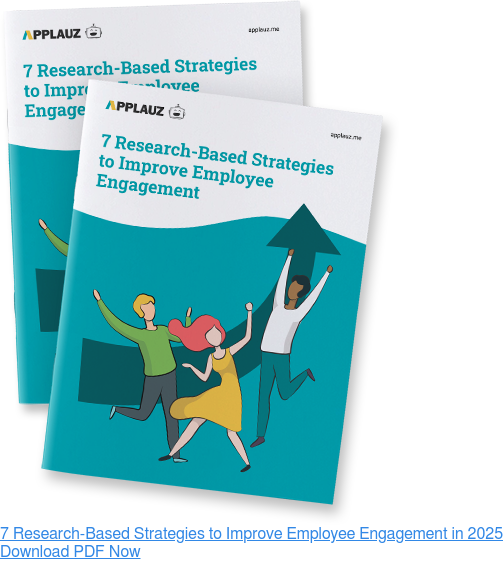Imagine you vowed to accomplish a large personal goal like "wanting to be healthier." How would you approach this goal?
You probably wouldn't approach a total lifestyle overhaul as something that can be attained overnight. We all know that fad diets and quick fixes don't work. Achieving a healthy lifestyle is about making small and consistent, positive changes in multiple facets of life – diet, exercise, sleep, etc.
When it comes to employee engagement, the same principles apply.
Nevertheless, many companies believe the solution to higher engagement is better snacks in the breakroom and allowing people to bring their dogs to work.
Although many of these ideas may be fun and temporarily boost morale, they are not the solution to lasting employee engagement.
Similar to your personal health goals, band-aid solutions don't work at work either.
A passion for excellence
To that end, employee engagement initiatives should go deeper than making surface-level changes to a work environment.
Employees who feel engaged are more passionate and emotionally connected to their jobs. As such, engaged employees are more likely to agree with some of the following comments:
- The leaders of this organization display integrity.
- I find my job interesting and challenging.
- My opinions seem to count at work.
- If I contribute to the organization's success, I know I will be recognized.
- I see professional growth and career development possibilities for myself in this organization.
As you can see, the experiences of highly engaged people have little to do with the types of snacks available in the break room and more to do with the emotional and intellectual components of a work environment.
That said, despite the abundance of research espousing the ROI and benefits of an engaged workforce, some leaders and companies are still reluctant to invest in employee engagement.
This skepticism is further solidified by the many myths and misconceptions that float around in the employee engagement space.
Demystifying engagement
Many faulty beliefs hold businesses back from investing adequate time and resources into employee engagement. As a result, these myths prevent companies from building truly successful employee experiences that drive retention and employee loyalty.
Let's put all that confusion aside – once and for all. Because if you boil employee engagement down to its core components, you'll quickly see that the heart of engagement is rooted in basic psychology. In other words, it’s rooted in human universals.
Let's explore this idea further by exposing some of these common misunderstandings. So you can start developing a strategic approach to employee engagement – without stress or confusion.
 5 Employee Engagement Myths That Are Hurting your Employee Experience
5 Employee Engagement Myths That Are Hurting your Employee Experience
Myth 1 - A good salary should be enough to keep employees engaged
A good salary is desirable – no one can deny this fact. Money is a great external motivator. But, it is a lousy internal motivator. In fact, external rewards, like money, have been shown to diminish internal motivation in psychological studies.
Despite research citing the hidden costs of external rewards, many leaders continue to believe money is enough to keep employees loyal and engaged.
Author Leigh Branham unpacks this misconception in the book The 7 Hidden Reasons Employees Leave.
After analyzing data from thousands of exit interviews, Branham confirms this myth is far from reality. Her research findings show that only a small percentage (12%) of employees reported leaving for more money.
88% said that they left for a reason other than money -- the most common was actually psychological, such as not feeling trusted or valued.
Bottom line: Salary is only one piece of the employee engagement puzzle. Offering a good salary is not enough to drive long-term engagement. For instance, if employees don't feel valued and appreciated, they are more likely to become disengaged, regardless of how much you pay them.
Myth 2 - Only tech companies or businesses in creative industries can benefit from employee engagement
Although there is no magic formula to achieve it, every company can benefit from employee engagement. That said, an engagement strategy will change according to the organizational culture and employee needs. There are, however, guidelines and best practices that every company can follow to work towards higher engagement, no matter what industry you work for.
For instance, whether your employees are young 20-something techies or middle-aged factory workers, employee engagement is rooted in human fundamentals. In other words, universal principles, such as the need for appreciation, recognition or the desire to work towards a greater purpose, other than money.
To that end, you don't have to be the hippest company on the block to support greater employee appreciation, for example – saying thank you is free. And even if your company sells something as unsexy as flooring materials, you can still create purpose with an admirable mission like "we make every customer feel special." Or with social initiatives that give back to your local community.
Myth 3 - Employee engagement requires a big budget
Psychologist Dr. Paul White is a workplace expert and researcher on the topic of appreciation in the workplace and the author of the book The 5 Languages of Appreciation in the Workplace.
White’s research aims to understand what type of appreciation employees truly cherish. Using his Motivating by Appreciation (MBA) Inventory, White has surveyed over 100,000 employees to get to the bottom of appreciation in the workplace. After analyzing all the data from his research, White uncovered some fascinating insights.
Overwhelmingly, employees choose words of affirmation as the main way they want to be shown appreciation in the workplace.
And the second most desired form of appreciation is quality time from a manager or supervisor. The major takeaway from these findings: Employee engagement doesn’t require a huge budget.
Supporting engagement can be surprisingly cost-effective. For example, starting with company leaders and managers taking small, but consistent steps to communicate genuine and personalized appreciation to employees. This can be done by prioritizing frequent verbal or written recognition with a recognition program. Or by simply carving out time for regular one-on-one meetings.
Myth 4 - Companies don’t have control over how engaged an employee is, it’s an attitude that an employee either has or doesn’t
If you voiced dissatisfaction about something in a relationship or friendship, and your significant other or friend replied by telling you that the problem was not them, but rather your bad attitude, how would you feel? Probably quite upset and resentful!
When it comes to the workplace, many companies behave like these insensitive spouses or friends. They believe that employee engagement is an attitude or character trait that an employee either has or doesn’t. For instance, if work is stressful and overwhelming, it’s the employee’s responsibility to better manage their attitude, time, and stress.
But looking at findings from a Gallup study that surveyed 7,500 full-time employees, it becomes clear that the root causes of employee burnout are factors that lie outside the individual. For instance, consider the top five reasons for burnout:
- Unfair treatment at work.
- Unmanageable workload.
- Lack of role clarity.
- Lack of communication and support from their manager.
- Unreasonable time pressure.
Bottom line: employees who have a naturally good attitude might fare better in times of stress. But if a work environment is fundamentally unhealthy and driven by harmful norms, even the most resilient employees will break down, disengage, and eventually, burn out.
Myth 5 - Employee engagement is an insurmountable goal
We won’t sugar coat it – achieving engagement is not a simple task. It’s a multi-phase mandate that involves careful, strategic planning. All that to say, it’s a big goal, but it’s surely not impossible.
Like any other large goal, the key to success is breaking it down into digestible and simple steps. In other words, many smaller short-term initiatives build up over time to create a workplace with high engagement.
The key to success is to focus on each initiative, one-by-one. In other words, take it one step at a time. Each step will lead you closer to the bigger picture of greater employee engagement.
Final Thoughts
Greater happiness is something we would all like to strive towards. But anyone with a bit of life experience will tell you that there isn't one material object, action, or achievement that guarantees enduring happiness. In other words, happiness is a moving target.
Although I've mentioned the idea of "achieving" employee engagement, it's important to remember that employee engagement is similar to happiness. In other words, there isn't one initiative or perk that you can offer employees that will guarantee engagement.
Bottom line: engagement isn't something you reach and then can simply stop working on. Just like wanting to be healthier or happier, engagement is the product of developing consistent positive habits. But most importantly, maintaining these positive habits over time.
About the author
 Michelle Cadieux
Michelle Cadieux
Michelle is a content writer for Applauz. She holds a Bachelor's degree in Psychology from Concordia University, and she has been writing about work and employee happiness for over five years.



